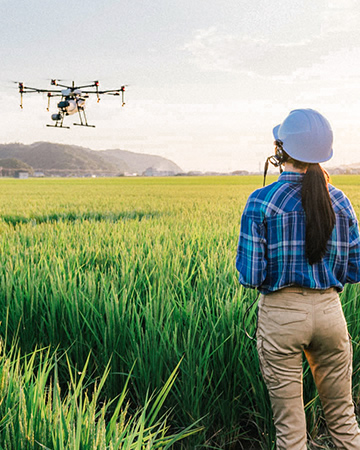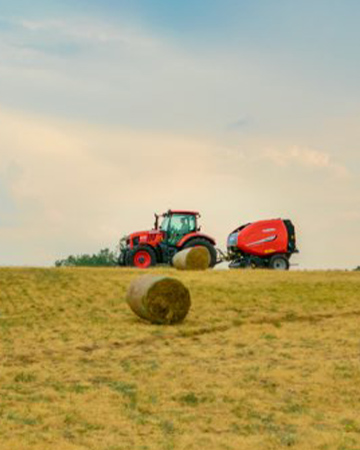
In 2023, Japan and the Association of Southeast Asian Nations (ASEAN) marked 50 years of partnership and cooperation. A Commemorative Summit meeting is expected to be held in Tokyo in December, where a new vision for cooperation will be announced. Southeast Asia continues to see remarkable growth and development but faces the challenges of achieving economic growth while conserving the environment and reducing greenhouse gas emissions, calling for further cooperation with Japan.
The greatest issues facing the agricultural sector in Southeast Asia are the severe droughts driven partly by global boiling and air pollution caused by slash-and-burn farming. Underlying these crises is poverty among the farmers. As rural workers move to cities, the agricultural workforce ages, and water resources are depleted, more challenges have emerged. One place where members in the agricultural sector travel to seek solutions is located on a plateau in central Thailand. We visited the demonstration farm KUBOTA FARM in Thailand (hereinafter KUBOTA FARM), which researches and puts into application on a daily basis “agriculture of the future,” while paying close attention to local needs.
The History of Kubota Advancing Together with Thai Agriculture
With a tropical monsoon climate and large areas of flat land, Thailand is a major agriculture-producing country with 40% of its land classified as agricultural. In addition to rice, which represents Thai agriculture (ranked 6th worldwide), the country is one of the world's leading producers of sugarcane (5th worldwide) as well as cassava (4th worldwide). It is also one of the leading producers of tropical fruits such as pineapple and durian.

Kubota was the first company to start selling Japanese tillers in the 1960s, when agricultural mechanization began. In 1978, the company launched a joint venture with the leading materials manufacturer Siam Cement and expanded the local production of agricultural diesel engines and tillers. In the 1990s, tractors were introduced. However, their use did not spread due to their high cost relative to the farmers’ income.
A major turning point came when locally customized tractors were developed. In a temperate environment where farming takes place throughout the year, machines operate for longer hours, which results in increased load. After fully understanding the Thai farmers’ needs, the engineers from Japan developed a tractor that was durable, yet easy to maintain and inexpensive.
At the same time, Kubota strove to enhance its after-sales service. Dealerships were equipped to quickly respond to farmers’ requests, with replacement parts in stock. After gaining the trust of farmers and steadily increasing its sales, the Thai plant began the mass production of tractors in 2009.

The Issues in Thai Agriculture and Challenges for Kubota
Though Thai agriculture may seem to have a very favorable environment, it is currently facing many hurdles: low productivity, aging of the workforce, and environmental issues.
Approximately 30% of Thailand’s labor force is working in the agricultural sector. However, agriculture only accounts for 10% of the total GDP (Gross Domestic Product), which indicates how much value is added.*1 The rice yield per area is among the lowest in Southeast Asia, and the status of the country as a rice exporter is on the decline.*2 The average age of workers is also increasing as the younger generation moves away from agriculture due to its labor intensiveness and limited growth in income.
- *1.United Nations Thailand: https://thailand.un.org/en/103307-thai-agricultural-sector-problems-solutions
- *2.United States Department of Agriculture (USDA): https://www.fas.usda.gov/data/world-agricultural-production
Therefore, the Thai government's national strategy focuses on increasing productivity and promoting sustainability as the highest priority. One of the key government policies Thailand 4.0 aims to accelerate digitalization in the economic and societal sectors in order to boost productivity. Another policy named the Bio-Circular-Green (BCG) Economic Model aims to implement environmental measures while promoting economic recovery. Agriculture is one of the important pillars forming the basis of these policies, leading to the progress of smart agriculture.

It is said that farmers’ “income is not commensurate with the workload” and that “the younger generations have a strong image that ‘farming is tough/labor intensive’." Through their daily interactions with farmers, the staff at SIAM KUBOTA Corporation Co., Ltd. (SKC) shared these views of the challenges facing the agricultural industry. They envisioned creating place where anyone could readily experience agriculture as a smart and attractive industry. With such hope, the construction of KUBOTA FARM began in 2019.
A Place to Find Answers
“Visitors don’t just observe but get to experience farming here. We want this to be a place to find the answers to the problems farmers face.”
When we visited KUBOTA FARM in Chonburi Province in central Thailand, we were welcomed by its manager, Sanguancheewin Ratchakrit. KUBOTA FARM was created to promote research and development specifically for the ASEAN region and to invite dealers and farmers to come and experience cutting-edge agricultural technology to foster the next generation of agricultural workers. The site spreads over 35 hectares of land and is divided into 10 zones, which include precision rice and modern field crop cultivation zones, facilities to experience the latest technologies as well as training sites. Ratchakrit explained each zone during our tour.

In the Precision Rice Farm and Crop Rotation Zone, state-of-the-art rice transplanters and tractors operate in the expansive lush paddy fields. Paddy rice is a symbolic crop of Thailand, but there are many regions where the soil is not optimal or water availability is scarce. It is critical to develop the technology to improve the soil and to cultivate rice efficiently using minimal resources. In fact, KUBOTA FARM is located in a sandy soil area, where it is difficult to grow rice. Therefore, it had to start with soil improvement.
“We worked on improving the soil for rice cultivation by analyzing and determining the necessary components and nutrients. The next step after enriching the soil was irrigation. Soil alone is not enough, nor water alone is enough. What is important in agriculture is having a balance. We created this place by combining/synthesizing SKC’s expertise with Thailand’s customary agricultural practices.”

In a cassava field in the Modern Field Crops Farm Zone, a tractor makes ridges as it advances. The rear implement cuts the long, thin saplings to an appropriate length and inserts them into the soil.
“Before the creation of this tractor, all the cutting and planting of the sturdy stems were done by hand, and that was the hard part of growing cassava. Moreover, the cut would be slanted at an angle by hand, but, according to joint research with a university, cassava grows larger and more evenly if cut horizontally. The machinery can make straight cuts, and a single machine can handle all four tasks of ridging, cutting, planting, and fertilizing.”

There is still a lot of potential for mechanization in cultivating field crops. For example, no technology has been developed to harvest such crops as natural rubber or durian. Thus, KUBOTA FARM operates as an open innovation center for SKC and all its partners. Steps for new discoveries and innovations are made every day to make such technologies a reality.
Protecting the Environment through the Zero-Burning Project
In the sugarcane fields, the “zero-burning (agriculture without burning)” policy has been implemented to eliminate air pollution caused by slash-and-burn agriculture, which has become a social problem in Southeast Asian countries. Ratchakrit says that Kubota’s stance to work closely with the farmers and government agencies to solve issues has led to its engagement in environmental endeavors.
One major source of air pollution is the practice of “cane burning” before the harvest. It is a method of efficiently removing unnecessary leaves before harvesting the stems, which remain after burning. However, not only does this generate smoke, but the stems are also sold at a lower price because of the burn.
“Originally, the reason for developing this machinery was to solve the problems the sugarcane farmers faced. The greatest problem was that there weren’t nearly enough people to harvest. In addition, there is the danger of workers being injured by the hard leaves during the harvesting and the hidden danger of snakes and pests that live in the fields. That is why farmers used to burn the leaves before harvesting.”
The zero-burn implement Sugarcane Leaf Remover developed by SKC clears the leaves from the stems by capturing them with cords. This allows farmers to harvest sugarcane without the fear of injury while increasing the value of the crop. Moreover, without burning, farmers can reduce smoke and carbon dioxide emissions, cashing in on the amount of reduction through the carbon credit system. Furthermore, farmers can use the cut leaves for biomass using equipment that gathers and forms them into a block.

“We thought about a good way to harvest the crop without burning it. In addition to sugarcane, this zero-burning method can also be applied to other crops such as rice and corn. Not only are we reducing carbon dioxide emissions, but we are also contributing to the realization of a circular economy by managing waste, taking the leaves that were previously discarded and finding value for them as fuel and energy.”
The Ever-Evolving KUBOTA FARM
It has been nearly three years since KUBOTA FARM was created. Despite shutdowns due to COVID-19, approximately 50,000 people have already visited not only from Thailand or Southeast Asian countries but from around the world, as far away as Africa. KUBOTA FARM has welcomed many high-ranking government officials, including the Prime Minister of Thailand, who attended a discussion on the Thai Agricultural Transformation Policy. Visitors to the farm also include farmers who stay for an average of four hours, view the latest technology in action, take a test drive, and decide to purchase products on-site. There are also 2,000 farmers in seven groups who have started smart farming after their visit. KUBOTA FARM promotes technological advancements, addressing the challenges presented by farmers and developing equipment such as tomato harvesting robots and crop-dusting drones.
“We are always thinking five years into the future as we advance our projects. In general, we imagine that a technology can be put to practical use by farmers about five years after it is developed. Our aim is to gather various technologies from all over the world and practically apply them so that Kubota can accumulate agricultural know-how and then go on to provide it to farmers.”
New zones are still being built on one side of the Farm. The plan is to ultimately expand to 12 zones and increase the number of solutions KUBOTA FARM has provided from 70 to 100 in the near future.
“Customers seek new research and solutions. We will work to ensure that KUBOTA FARM is constantly evolving so that even if people have already been here once, if they come back a year later, it will be completely different.”
As he speaks passionately about the Farm, Ratchakrit’s gaze is fixed on the solid future he sees for Thai agriculture. The success achieved here should also contribute significantly to the solution of food, water, and environmental problems in Southeast Asia and the world.





